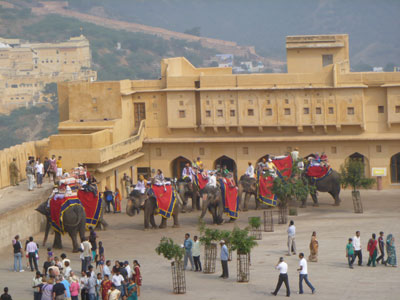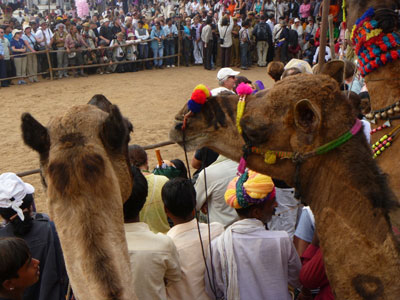Chaos, color and camels on a tour of Northern India
by Betsy and Bob Burnett; Jeffersonton, VA
Although we had traveled to many places, we hadn’t visited India, but the lure of the exotic and the prospects of visiting a cousin living there were the perfect excuses to go in November ’10. Accumulated frequent-flyer miles sweetened the pot.
We were lucky to find Easy Tours of India (Austin, TX; 888/597-9274 or 512/345-1122) online. Managing Director David Francis helped us book our tour and handled all of our extra requests and changes along the way. We found the company, throughout our tour, to be efficient, friendly and, above all, doing what they said they would do when they said they would do it.
First impressions
We arrived in New Delhi at 4 o’clock in the morning two days prior to the start of our tour and stayed at the lovely Oberoi. There is a time and place for spending money on comfort, and, as travelers of “a certain age,” we decided this was it.
We started by exploring the city with a car and driver, expecting everything and nothing. Realizing that one place does not reflect an entire country, the first impression we got of India was chaos, confusion, contrast and color.
There are over one billion people in India and more than one million cars in Delhi, alone. The roads welcome cars, motorbikes, buses, tractors, cows, camels, bicycles, the occasional elephant and people — lots of people. There are few traffic lights, roundabouts or one-way signs, but it doesn’t matter; it all works.
The philosophy of both Muslims and Hindus seemed to be acceptance of any situation. No one got upset or angry. Live in the moment and life becomes more pleasurable.
Delhi and Agra
Our tour started with an all-day look at Delhi, including the Red Fort, Gandhi’s tomb, the India Gate and a rickshaw ride through the bazaar called Chandni Chowk.
There were nine of us on this tour and we all ended up great friends. Our principal guide, Narjee Rathore (e-mail narjee@gmail.com), was extremely well informed, with a good sense of humor and excellent English skills. He was attentive to all and easily established a personal relationship with each member of the group.
Our favorite activity that day was the rickshaw ride peppered with unfamiliar sounds, smells, color and commerce. Squeezing by small cars and dodging overhanging electric wires became a sport!
Then it was on to Agra and the Taj Mahal. Our room at another Oberoi, the Oberoi Amarvilas, had a spectacular view over the pool toward the Taj.
The town isn’t much, but the Taj Mahal is breathtaking. We had heard that there are two sites in the world that no amount of pictures can do justice to: the Taj Mahal and the Grand Canyon.
It’s not just the spectacular architecture of the building but also the inexplicable spirituality of the place, which can’t be diminished by the crowds of visitors — a truly worthwhile experience. However, I wouldn’t recommend going inside the building, as the crush of people can be worse than in the New York subway during a bus strike.
Tiger spotting
On our way to Ranthambore National Park the following day, we visited the UNESCO World Heritage Site of Fatehpur Sikri, the now-uninhabited city built by Emperor Akbar in the 16th century. Little imagination was needed to envision hundreds of people strolling through the grounds, the veiled faces of women in purdah (traditional concealment from men) peering out of the latticed openings.
We spent two nights at the Sawai Madhopur Lodge near Ranthambore.
This park, renowned for its tiger conservation program, claims to have about 30 tigers in its 400-square-kilometer area. In 1950 there were approximately 5,000 tigers across India, but by 2008 that number had been reduced to approximately 1,400 due, in large part, to poaching.
Although my husband and I were unlucky in our pursuit of tiger sightings, three of the others succeeded. Oh, well, the hunt is everything, and we did enjoy seeing tiger tracks, birds, mongooses and a jackal.
The jeep safaris (two per day) were exciting, and the very knowledgeable guides worked hard at spotting the elusive.
Carpets and camels
Two nights in Jaipur were next on the list. Upon arrival, we were taken to a carpet-and-textile house that did exquisite work. Some in our group bought carpets.
For us, the highlight of our Jaipur excursion was a visit to nearby Amber Fort, an exciting complex of chambers, ramparts and artistic excellence, with our approach to the main gate on elephantback. There is also very good jewelry shopping in the area.
Our hotel in the city was the Jai Mahal Palace, a former palace that, sadly, could use some attention to detail. The room was lovely, but small things such as fingerprints on the walls, not enough towels and poor restaurant service were noticeable.
Next came what, for us, was the highlight of the entire trip: the Pushkar Camel Fair. Although the fair attracts many tourists, the main thrust of it is the buying and selling of camels, cattle and Marwari horses, something that interested us, coming from a farm in Virginia. We watched livestock being shown to prospective buyers and saw a performance of horsemanship and a camel race.
Riding camels back to our resort, my husband and I were given the reins so the camels could trot — a different but not uncomfortable experience.
That evening we enjoyed dinner in Pushkar, a town famous for its sacred lake and one of only a few temples in the world dedicated to Brahma.
We liked this small town’s atmosphere and would visit it again out of season. Local shopping was good for bangles, T-shirts and small souvenirs.
We returned to the Pushkar Bagh Resort, which was basic but comfortable. It had no pool but offered some entertainment at night — puppeteers or dancers with accompanying music. The food, served buffet style, was local and tasty.
On to Udaipur
The following morning the two of us and our guide, Narjee, set out for Udaipur by car. Along the way, we stopped in a small village to see a man who produces dhurrie rugs of his own design.
Like many of his neighbors, he and his family have been engaged in weaving for several generations. We bought a few of his creations right on the spot and they were delivered to our farm before we returned home!
Arriving in Udaipur at the Fateh Prakash Palace Hotel, we heard drums and whistles. Narjee explained that there must be a wedding taking place, so we followed the noise and found the groom mounted on a white horse surrounded by all his friends. There was a band and the men were dancing in the streets. What a sight!
After an hour, they boarded a number of boats and went out to an island in the lake for the all-night wedding.
The area of Udaipur in which we stayed was actually the old palace complex. The current Maharaja still lives there and makes himself quite visible.
An enormous palace that takes at least two hours to visit, it is lovely, colorful and very grand. We also took a boat ride on the lake and visited the island where the wedding took place, with its lovely gardens and fountains.
Varanasi
After a detour to visit Bob’s cousin outside of Mirzapur, we went on to Varanasi. The next morning, a new Easy Tour guide took us to Sarnath and its temple dedicated to Buddha and featuring many scenes from his life exquisitely painted on the walls.
Varanasi is, of course, the site of much activity on the sacred Ganges. An evening boat ride on the river was a lovely opportunity to float lighted candles in memory of those who have passed on.
Washing laundry, bathing, praying and even performing burial rites are all part of daily life on the river. Take the time to just sit and absorb the past, present and future of Indian culture in this microcosm.
Our trip, which cost around $9,000 for two, including all transportation within India, guide services, hotels and some meals, was not really a vacation but, rather, an experience. It may take a while to process all we saw, but we would return at any time to take on more.
India is not for those offended by trash, traffic, comparative poverty and dirt. It is, however, for those who wish to experience an ancient culture and the welcoming warmth and generosity of lovely people.




